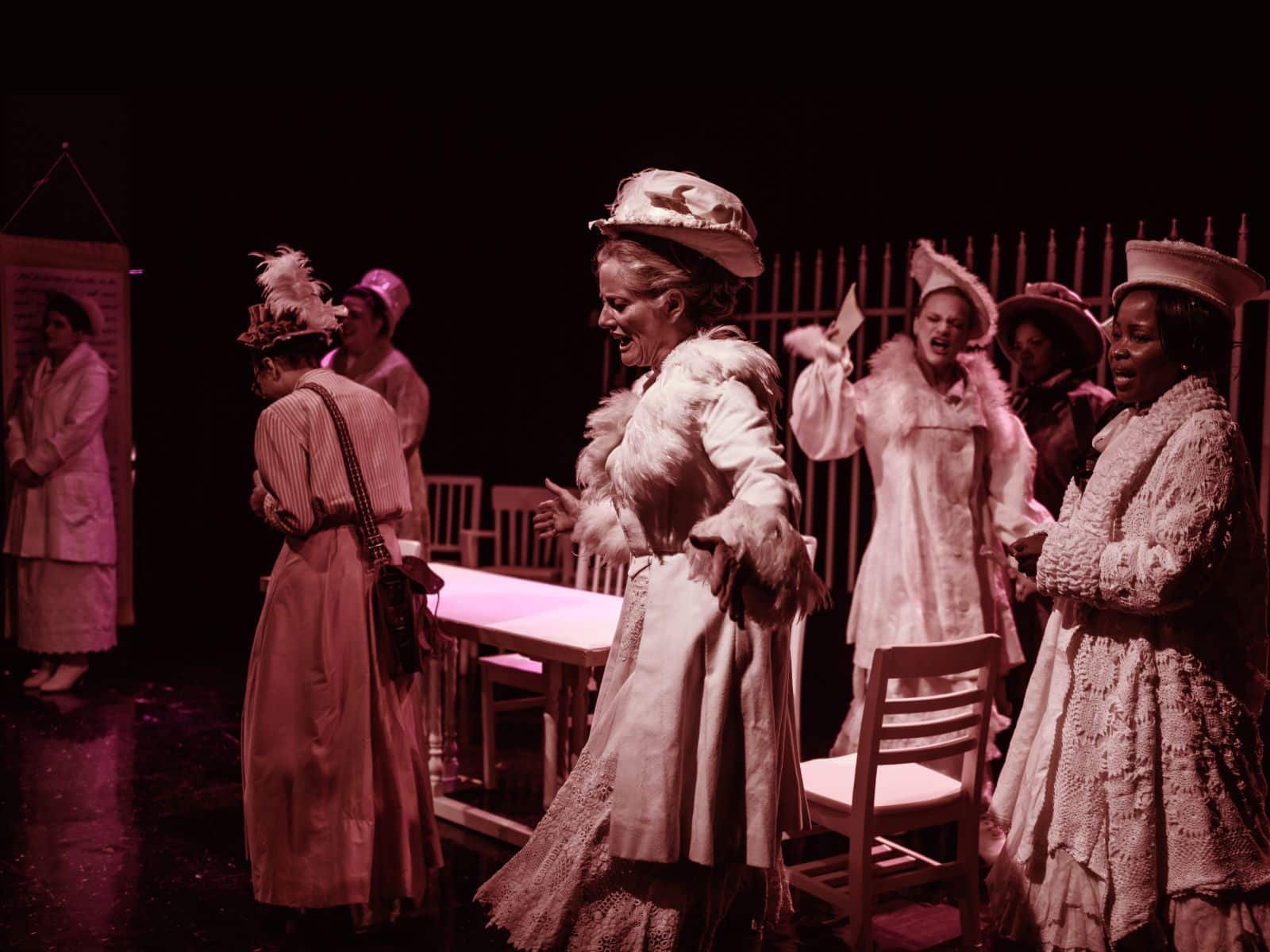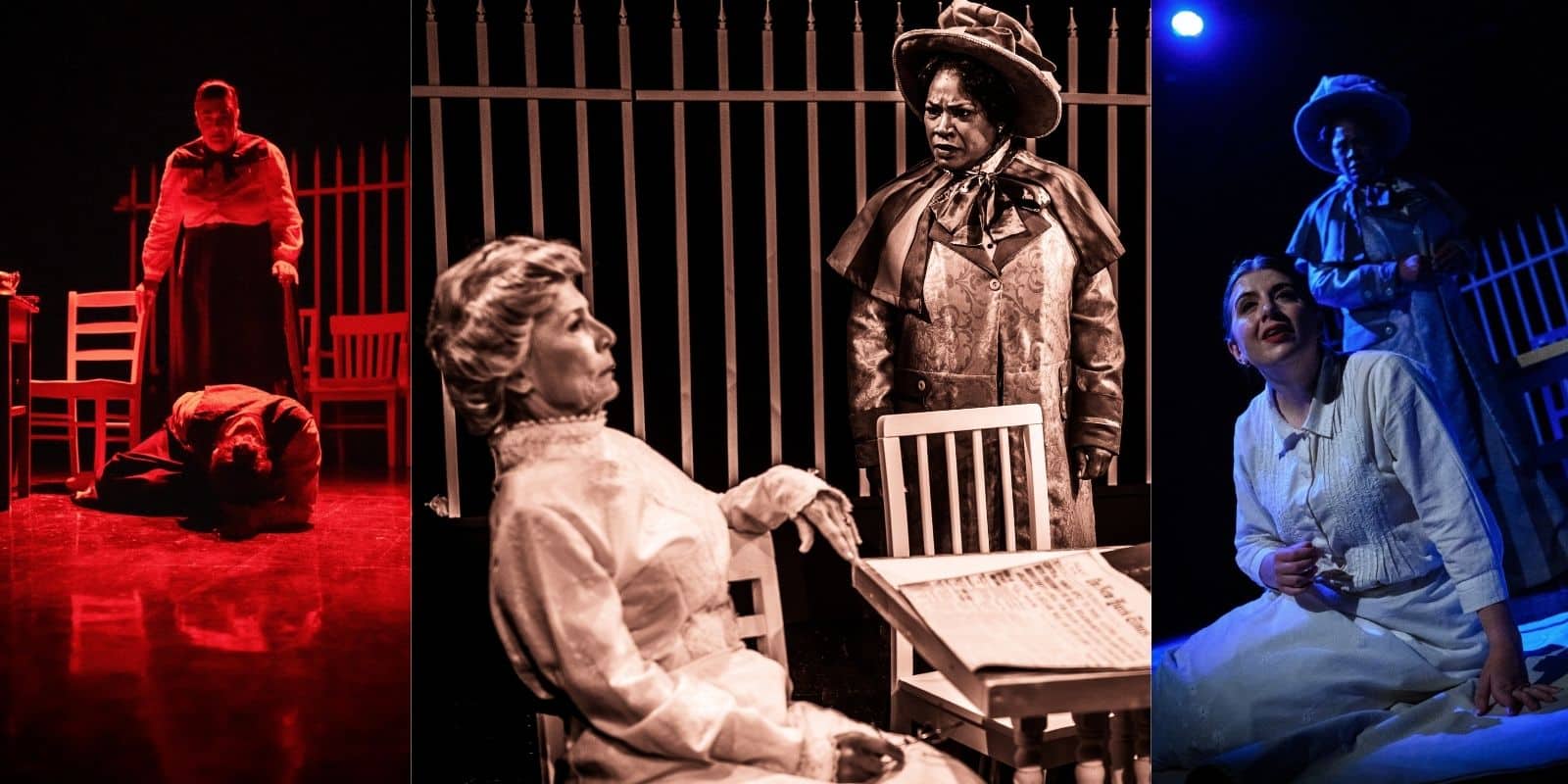The suffragist movement, like many fights for civil liberties, is often presented as a straightforward victory. A relay race to the top of The Hill, where Man was waiting with open arms to claim Woman as equal. Famous female activists like Dr. Anna Howard Shaw and Ida B. Wells are placed into a fairytale where all womankind unite to pass the 19th Amendment and then live happily ever after. What’s the real story? Pipeline Playwrights’ It’s My Party! takes a stab at the truth. Written by Ann Timmons and directed by Rikki Howie Lacewell, the play examines the rivalry between the National American Women Suffrage Association (NAWSA) and the National Women’s Party (NWP). But this is no objective history lesson. Alice Paul, founder of NWP, is the heroine, fighting a war on two fronts: the men who hoard political power and the women willing to play their games.
It’s My Party! opens on an empty table, center stage, filled only with the disembodied voices of congressmen. “Yay.” “Nay.” It’s 1919, and the suffragists listen on the sidelines with bated breath as Congress votes on the 19th Amendment. On one side, the women of NAWSA; on the other, the women of the NWP. The House passes the Susan B. Anthony Amendment, and the respective attitudes of the actresses reveal where the pendulum swings in this retelling.

Pat Nicklin’s haughty portrayal of Carrie Chapman Catt gives the character the acerbic aura of a wicked stepmother. Catt indulges in a smug, self-gratifying celebration. She will be the one to greet the press, not Alice and her “hooligans.” Sarah Millard embodies the fiery temperament of Lucy Burns, Alice’s right-hand woman. Every time she wrinkled her nose with joy or threw back her head in outrage, I too was carried away by the ferocity of her emotions.
The NWP are indignant at the reduction of their importance in achieving women’s suffrage. Their complaints felt meta, as did much of the play’s dialogue, and this self-awareness of its own relevance was the production’s greatest strength. As Alice Paul, Marissa Liotta captured the audience’s unwavering attention with passionate calls to action that stiffened the spines of everyone present. Sonja Dinkins, portraying Ida B. Wells-Barnett, created an imposing presence with a steely cadence, delivering each sentence as a verbal strike. These riveting performances were aided by scenes dense with standout lines, such as “Middle-class white women think they can change the world by themselves — it’s almost funny.”
The play jumps between important moments and locations in women’s suffrage history. Its timeline does more than highlight key points; it makes an argument. After the initial confrontation in 1919, we’re taken back to 1912, when these great minds clash for the first time. The women take center stage now. We see younger versions of Alice and Lucy join NAWSA, believing they can shift the organization’s methods from state lobbying toward direct participation, which Lucy proclaims “is the only way to get things done.” The rest is history, and the throughline is Alice’s journey.
Timmons’ script humanizes Alice more than the other women. Beyond Alice’s monologues, presented as prayers and private musings, we’re granted full access to her mind through hallucinations as she withers away in a psychiatric ward. Her health episodes get the red-light treatment; meanwhile, Lucy’s mental breakdown is overshadowed by the disappointment her leave causes Alice.

Liz Weber’s Dr. Shaw, costumed in silver hair and gray, metallic clothing, is a relic of the past to be discarded, which happens without mention as she quietly disappears from the narrative. Dr. Shaw is portrayed as an outdated idea rather than a person. Her successor, Catt, embodies this same idea toward the end of the play, both in wardrobe (transitioning from earth tones to grayscale, costumes by Marty Van Kleeck) and in words. “You’ve set us back months, if not years,” they each say on separate occasions to Alice and Lucy, bookmarking the play with their anti-radical sentiments.
Ida is perhaps the most conceptual character, representing the entirety of Black women’s suffrage and the racial tensions within the movement. The Ida we see must exist within the boundaries of a story that centers on white achievement; therefore, she is angry and nothing else.
I do, however, understand the overall lack of complexity in the characters. Director Rikki Howie Lacewell has often said she encourages actors to “go to the door, not through the door.” I see that here, in the care taken to bring historical figures to life in a way that honors the voices they’re known for. It’s My Party! doesn’t push its heroines into the realm of historical fiction. Instead, it stands in that doorway, inviting the audience to look back at the real women who opened it first.
Running Time: One hour and 45 minutes, including a 15-minute intermission.
It’s My Party! plays through October 26, 2025, presented by Pipeline Playwrights performing at Theatre on the Run, 3700 S Four Mile Run Drive, Arlington, VA. Purchase tickets ($33 for general admission and student tickets for $23) online.
The digital program is downloadable here.
Lighting Design by Alana Isaac; Set Design by Justin Nepomuceno; Costume Design by Marty Van Kleeck; Composer and Musician: Rick Bassett; Costume Coordinator and Artist: Maria V. Bissex



